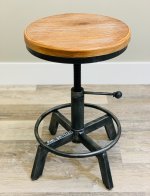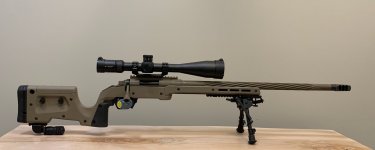This is going to be a question, that on the surface, will sound illogical, but bear with me.
I am teaching myself to shoot long distance, up to 1000 yards, with a view towards later participation in F-Class, Precision Rifle, and maybe in the future even some informal Benchrest shooting.
For F-Class shooting I will use a Rempel F-Class bipod and Protektor DR Flattop rear bag with mid ears, 1" slot (widest available), and filed with :Heavy Sand" (20 lb total weight for the bag).
For PRS shooting I will use a Harris bipod and a Tab Gear STR8Laced Ultra Light Rear Bag.
I have a PGW Defence M15-XRS, which is a Remington 700 pattern rifle on an MDT XRS chassis. Caliber is 6.5 Creedmoor. Recoil is very light as I am, and will continue, to use handloads based on the 120g Hornady ELD Match bullet. One non-typical feature; The XRS chassis has a toe that is 1.25" wide on the bottom, which includes a 1/8" radius on each side edge. The rifle shoots 5-shots 100 yard groups under 0.33 inch, even with my amateurish techniques at this point. The rifle with 24" heavy fluted barrel and scope weighs 14 lb.
I am doing load development, and for the load development, I have some specific objectives:
- Test the loads using the Rempel and Harris bipods, as that is what I will be using for actual shooting
- Factor out the human element as much as possible, as I want to test the ammunition I make, not the rifle, and not my technique (which is still amateurish).
So, I want to use "Benchrest" techniques to the extent possible.
Given the rifle, the 2 very different bipods, and my objectives, what load testing setup guidance (equipment and techniques) can any of you experienced in either F-Class or PRS or Benchrest offer to a newbie in these types of shooting?
Jim G
I am teaching myself to shoot long distance, up to 1000 yards, with a view towards later participation in F-Class, Precision Rifle, and maybe in the future even some informal Benchrest shooting.
For F-Class shooting I will use a Rempel F-Class bipod and Protektor DR Flattop rear bag with mid ears, 1" slot (widest available), and filed with :Heavy Sand" (20 lb total weight for the bag).
For PRS shooting I will use a Harris bipod and a Tab Gear STR8Laced Ultra Light Rear Bag.
I have a PGW Defence M15-XRS, which is a Remington 700 pattern rifle on an MDT XRS chassis. Caliber is 6.5 Creedmoor. Recoil is very light as I am, and will continue, to use handloads based on the 120g Hornady ELD Match bullet. One non-typical feature; The XRS chassis has a toe that is 1.25" wide on the bottom, which includes a 1/8" radius on each side edge. The rifle shoots 5-shots 100 yard groups under 0.33 inch, even with my amateurish techniques at this point. The rifle with 24" heavy fluted barrel and scope weighs 14 lb.
I am doing load development, and for the load development, I have some specific objectives:
- Test the loads using the Rempel and Harris bipods, as that is what I will be using for actual shooting
- Factor out the human element as much as possible, as I want to test the ammunition I make, not the rifle, and not my technique (which is still amateurish).
So, I want to use "Benchrest" techniques to the extent possible.
Given the rifle, the 2 very different bipods, and my objectives, what load testing setup guidance (equipment and techniques) can any of you experienced in either F-Class or PRS or Benchrest offer to a newbie in these types of shooting?
Jim G


